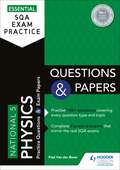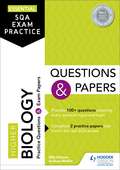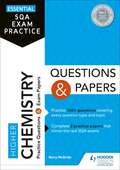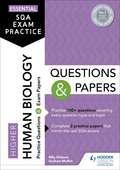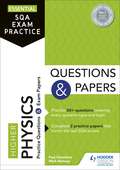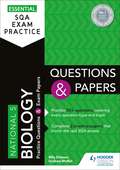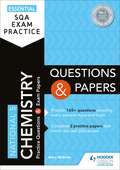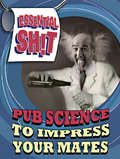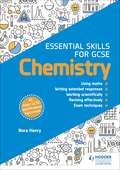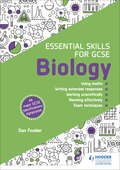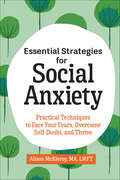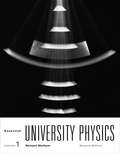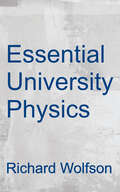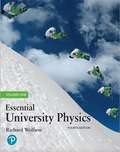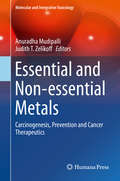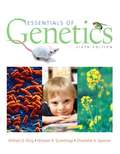- Table View
- List View
Essential SQA Exam Practice: From the publisher of How to Pass
by Paul Van der BoonExam board: SQALevel: National 5Subject: PhysicsFirst teaching: September 2017First exam: Summer 2018Practice makes permanent. Feel confident and prepared for the SQA National 5 Physics exam with this two-in-one book, containing practice questions for every question type and topic, plus two full practice papers - all written by an experienced examiner.- Choose to revise by question type or topic: A simple grid enables you to pick particular question styles or course areas that you want to focus on, with answers provided at the back of the book- Understand what the examiner is looking for: Clear guidance on how to answer each question type is followed by plenty of questions so you can put the advice into practice, building essential exam skills- Remember more in your exam: Repeated and extended practice will give you a secure knowledge of the key areas of the course (dynamics; space; electricity; properties of matter; waves; radiation)- Familiarise yourself with the exam paper: Both practice papers mirror the language and layout of the real SQA papers; complete them in timed, exam-style conditions to increase your confidence before the exams- Find out how to achieve a better grade: Answers to the practice papers have commentaries for each question, with tips on writing successful answers and avoiding common mistakesFully up to date with SQA's requirementsThe questions, mark schemes and guidance in this practice book match the requirements of the revised SQA National 5 Physics specification for examination from 2018 onwards.
Essential SQA Exam Practice: Higher Biology Questions and Papers
by Graham Moffat Billy DicksonExam board: SQALevel: HigherSubject: BiologyFirst teaching: September 2018First exam: Summer 2019Practice makes permanent. Feel confident and prepared for the SQA Higher Biology exam with this two-in-one book, containing practice questions for every question type and topic, plus two full practice papers - all written by experienced examiners.- Choose to revise by question type or topic: A simple grid enables you to pick particular question styles or course areas that you want to focus on, with answers provided at the back of the book- Understand what the examiner is looking for: Clear guidance on how to answer each question type is followed by plenty of questions so you can put the advice into practice, building essential exam skills- Remember more in your exam: Repeated and extended practice will give you a secure knowledge of the key areas of the course (DNA and the genome; metabolism and survival; sustainability and interdependence)- Familiarise yourself with the exam papers: Both practice papers mirror the language and layout of the real SQA papers; complete them in timed, exam-style conditions to increase your confidence before the exams- Find out how to achieve a better grade: Answers to the practice papers have commentaries for each question, with tips on writing successful answers and avoiding common mistakesFully up to date with SQA's requirementsThe questions, mark schemes and guidance in this practice book match the requirements of the revised SQA Higher Biology specification for examination from 2019 onwards.
Essential SQA Exam Practice: Higher Chemistry Questions and Papers
by Barry McBrideExam board: SQALevel: HigherSubject: ChemistryFirst teaching: September 2018First exam: Summer 2019Practice makes permanent. Feel confident and prepared for the SQA Higher Chemistry exam with this two-in-one book, containing practice questions for every question type and topic, plus two full practice papers.- Choose to revise by question type or topic: A simple grid enables you to pick particular question styles or course areas that you want to focus on, with answers provided at the back of the book- Understand what the examiner is looking for: Clear guidance on how to answer each question type is followed by plenty of questions so you can put the advice into practice, building essential exam skills- Remember more in your exam: Repeated and extended practice will give you a secure knowledge of the key areas of the course (chemical changes and structure; nature's chemistry; chemistry in society; researching chemistry)- Familiarise yourself with the exam papers: Both practice papers mirror the language and layout of the real SQA papers; complete them in timed, exam-style conditions to increase your confidence before the exams- Find out how to achieve a better grade: Answers to the practice papers have commentaries for each question, with tips on writing successful answers and avoiding common mistakesFully up to date with SQA's requirementsThe questions, mark schemes and guidance in this practice book match the requirements of the revised SQA Higher Chemistry specification for examination from 2019 onwards.
Essential SQA Exam Practice: Higher Human Biology Questions and Papers
by Graham Moffat Billy DicksonExam board: SQALevel: HigherSubject: Human BiologyFirst teaching: September 2018First exam: Summer 2019Practice makes permanent. Feel confident and prepared for the SQA Higher Human Biology exam with this two-in-one book, containing practice questions for every question type and topic, plus two full practice papers - all written by experienced examiners.- Choose to revise by question type or topic: A simple grid enables you to pick particular question styles or course areas that you want to focus on, with answers provided at the back of the book- Understand what the examiner is looking for: Clear guidance on how to answer each question type is followed by plenty of questions so you can put the advice into practice, building essential exam skills- Remember more in your exam: Repeated and extended practice will give you a secure knowledge of the key areas of the course (human cells; physiology and health; neurobiology and immunology)- Familiarise yourself with the exam papers: Both practice papers mirror the language and layout of the real SQA papers; complete them in timed, exam-style conditions to increase your confidence before the exams- Find out how to achieve a better grade: Answers to the practice papers have commentaries for each question, with tips on writing successful answers and avoiding common mistakesFully up to date with SQA's requirementsThe questions, mark schemes and guidance in this practice book match the requirements of the revised SQA Higher Human Biology specification for examination from 2019 onwards.
Essential SQA Exam Practice: Higher Physics Questions and Papers
by Paul Chambers Mark RamsayExam board: SQALevel: HigherSubject: PhysicsFirst teaching: September 2018First exam: Summer 2019Practice makes permanent. Feel confident and prepared for the SQA Higher Physics exam with this two-in-one book, containing practice questions for every question type and topic, plus two full practice papers - all written by experienced examiners.- Choose to revise by question type or topic: A simple grid enables you to pick particular question styles or course areas that you want to focus on, with answers provided at the back of the book- Understand what the examiner is looking for: Clear guidance on how to answer each question type is followed by plenty of questions so you can put the advice into practice, building essential exam skills- Remember more in your exam: Repeated and extended practice will give you a secure knowledge of the key areas of the course (our dynamic universe; particles and waves; electricity)- Familiarise yourself with the exam paper: Both practice papers mirror the language and layout of the real SQA papers; complete them in timed, exam-style conditions to increase your confidence before the exams- Find out how to achieve a better grade: Answers to the practice papers have commentaries for each question, with tips on writing successful answers and avoiding common mistakesFully up to date with SQA's requirementsThe questions, mark schemes and guidance in this practice book match the requirements of the revised SQA Higher Physics specification for examination from 2019 onwards.
Essential SQA Exam Practice: National 5 Biology Questions and Papers
by Graham Moffat Billy DicksonExam board: SQALevel: National 5Subject: BiologyFirst teaching: September 2017First exam: Summer 2018Practice makes permanent. Feel confident and prepared for the SQA National 5 Biology exam with this two-in-one book, containing practice questions for every question type and topic, plus two full practice papers - all written by experienced examiners.- Choose to revise by question type or topic: A simple grid enables you to pick particular question styles or course areas that you want to focus on, with answers provided at the back of the book- Understand what the examiner is looking for: Clear guidance on how to answer each question type is followed by plenty of questions so you can put the advice into practice, building essential exam skills- Remember more in your exam: Repeated and extended practice will give you a secure knowledge of the key areas of the course (cell biology; biology: multicellular organisms; biology: life on Earth)- Familiarise yourself with the exam paper: Both practice papers mirror the language and layout of the real SQA papers; complete them in timed, exam-style conditions to increase your confidence before the exams- Find out how to achieve a better grade: Answers to the practice papers have commentaries for each question, with tips on writing successful answers and avoiding common mistakesFully up to date with SQA's requirementsThe questions, mark schemes and guidance in this practice book match the requirements of the revised SQA National 5 Biology specification for examination from 2018 onwards.
Essential SQA Exam Practice: National 5 Chemistry Questions and Papers
by Barry McBrideExam board: SQALevel: National 5Subject: ChemistryFirst teaching: September 2017First exam: Summer 2018Practice makes permanent. Feel confident and prepared for the SQA National 5 Chemistry exam with this two-in-one book, containing practice questions for every question type and topic, plus two full practice papers.- Choose to revise by question type or topic: A simple grid enables you to pick particular question styles or course areas that you want to focus on, with answers provided at the back of the book- Understand what the examiner is looking for: Clear guidance on how to answer each question type is followed by plenty of questions so you can put the advice into practice, building essential exam skills- Remember more in your exam: Repeated and extended practice will give you a secure knowledge of the key areas of the course (chemical changes and structure; nature's chemistry; chemistry in society)- Familiarise yourself with the exam paper: Both practice papers mirror the language and layout of the real SQA papers; complete them in timed, exam-style conditions to increase your confidence before the exams- Find out how to achieve a better grade: Answers to the practice papers have commentaries for each question, with tips on writing successful answers and avoiding common mistakesFully up to date with SQA's requirementsThe questions, mark schemes and guidance in this practice book match the requirements of the revised SQA National 5 Chemistry specification for examination from 2018 onwards.
Essential SQA Exam Practice: National 5 Physics Questions and Papers
by Paul Van der BoonExam board: SQALevel: National 5Subject: PhysicsFirst teaching: September 2017First exam: Summer 2018Practice makes permanent. Feel confident and prepared for the SQA National 5 Physics exam with this two-in-one book, containing practice questions for every question type and topic, plus two full practice papers - all written by an experienced examiner.- Choose to revise by question type or topic: A simple grid enables you to pick particular question styles or course areas that you want to focus on, with answers provided at the back of the book- Understand what the examiner is looking for: Clear guidance on how to answer each question type is followed by plenty of questions so you can put the advice into practice, building essential exam skills- Remember more in your exam: Repeated and extended practice will give you a secure knowledge of the key areas of the course (dynamics; space; electricity; properties of matter; waves; radiation)- Familiarise yourself with the exam paper: Both practice papers mirror the language and layout of the real SQA papers; complete them in timed, exam-style conditions to increase your confidence before the exams- Find out how to achieve a better grade: Answers to the practice papers have commentaries for each question, with tips on writing successful answers and avoiding common mistakesFully up to date with SQA's requirementsThe questions, mark schemes and guidance in this practice book match the requirements of the revised SQA National 5 Physics specification for examination from 2018 onwards.
Essential Shit: Pub Science to Impress Your Mates (Essential Shit)
by Randall PefferThis is science but not as you know it - here you get all the really cool stuff they didn't teach you in the classroom but you've always wanted to know...For example, ever wondered why hair grows out your nose and ears and if cockroaches really would survive a nuclear blast? Do you wish you could crush a beer can on your forehead or open a door with a credit card? Then look no further, all will be explained here. This is the ultimate science textbook and will answer all your craziest science questions with clarity, practical guidance and, of course, mirth. This is the perfect source of pub ammo.
Essential Skills for GCSE Biology
by Dan FoulderBuild essential maths, literacy and working scientifically skills to boost marks in GCSE Biology and ensure that students reach their full potential.Suitable for all specifications, this skills book provides additional support and will help to:- Sharpen mathematical skills with plenty of practice questions and coverage of all the maths techniques needed for the exams.- Improve literacy skills with tips on how to write longer answers, plus peer-assessment marking activities.- Develop the working scientifically skills needed to plan, carry out and evaluate practical experiments, in order to secure the maximum number of marks.- Build confidence by putting skills into practice; using our three-step formula students will progress from worked examples to guided questions and exam-style questions, with fully-worked solutions in the book.- Raise performance in the exams with practical advice on how to revise effectively and tips on understanding the questions, command words and assessment objectives.
Essential Skills for GCSE Biology
by Dan FoulderBuild essential maths, literacy and working scientifically skills to boost marks in GCSE Biology and ensure that students reach their full potential.Suitable for all specifications, this skills book provides additional support and will help to:- Sharpen mathematical skills with plenty of practice questions and coverage of all the maths techniques needed for the exams.- Improve literacy skills with tips on how to write longer answers, plus peer-assessment marking activities.- Develop the working scientifically skills needed to plan, carry out and evaluate practical experiments, in order to secure the maximum number of marks.- Build confidence by putting skills into practice; using our three-step formula students will progress from worked examples to guided questions and exam-style questions, with fully-worked solutions in the book.- Raise performance in the exams with practical advice on how to revise effectively and tips on understanding the questions, command words and assessment objectives.
Essential Skills for GCSE Chemistry
by Nora HenryBuild essential maths, literacy and working scientifically skills to boost marks in GCSE Chemistry and ensure that students reach their full potential.Suitable for all specifications, this skills book provides additional support and will help to:- Sharpen mathematical skills with plenty of practice questions and coverage of all the maths techniques needed for the exams.- Improve literacy skills with tips on how to write longer answers, plus peer-assessment marking activities.- Develop the working scientifically skills needed to plan, carry out and evaluate practical experiments, in order to secure the maximum number of marks.- Build confidence by putting skills into practice; using our three-step formula students will progress from worked examples to guided questions and exam-style questions, with fully-worked solutions in the book.- Raise performance in the exams with practical advice on how to revise effectively and tips on understanding the questions, command words and assessment objectives.
Essential Skills for GCSE Combined Science
by Nora Henry Dan Foulder Roy WhiteBuild essential maths, literacy and working scientifically skills to boost marks in GCSE Biology and ensure that students reach their full potential.Suitable for all specifications, this skills book provides additional support and will help to:- Sharpen mathematical skills with plenty of practice questions and coverage of all the maths techniques needed for the exams.- Improve literacy skills with tips on how to write longer answers, plus peer-assessment marking activities.- Develop the working scientifically skills needed to plan, carry out and evaluate practical experiments, in order to secure the maximum number of marks.- Build confidence by putting skills into practice; using our three-step formula students will progress from worked examples to guided questions and exam-style questions, with fully-worked solutions in the book.- Raise performance in the exams with practical advice on how to revise effectively and tips on understanding the questions, command words and assessment objectives.
Essential Skills for GCSE Physics
by Roy WhiteBuild essential maths, literacy and working scientifically skills to boost marks in GCSE Biology and ensure that students reach their full potential.Suitable for all specifications, this skills book provides additional support and will help to:- Sharpen mathematical skills with plenty of practice questions and coverage of all the maths techniques needed for the exams.- Improve literacy skills with tips on how to write longer answers, plus peer-assessment marking activities.- Develop the working scientifically skills needed to plan, carry out and evaluate practical experiments, in order to secure the maximum number of marks.- Build confidence by putting skills into practice; using our three-step formula students will progress from worked examples to guided questions and exam-style questions, with fully-worked solutions in the book.- Raise performance in the exams with practical advice on how to revise effectively and tips on understanding the questions, command words and assessment objectives.
Essential Strategies for Social Anxiety: Practical Techniques to Face Your Fears, Overcome Self-Doubt, and Thrive
by Alison McKleroyEmbrace confidence—proven strategies to break free from social anxietySocial connections are an integral part of a joyful life, yet when you're held back by self-conscious thoughts and feelings, you can get stuck in a pattern of avoiding social situations. Essential Strategies for Social Anxiety provides you with an effective toolbox to face your fears and feel confident whether you're having a conversation, interviewing for a job, or speaking publicly.Drawing on a variety of practices—like CBT, ACT, and mindfulness—this guide not only teaches you all about social anxiety but also helps you employ actionable techniques to transform it. Learn to calm both body and mind, silence your inner critic, and restructure negative thoughts with practice dialogues, exposure exercises, meditation, and more.Essential Strategies for Social Anxiety features:Exercises for everyone—No matter how your social anxiety manifests, discover powerful ways to overcome it and connect with people in a more comfortable way.Easy-to-follow advice—Each chapter covers a different approach to dealing with your social anxiety, with step-by-step exercises to get the results you want in your life.Everyday examples—Get inspired by real-life anecdotes that demonstrate how these techniques have helped other people achieve breakthroughs in dealing with social anxiety.Start down the path to confidence and joy in your social life with this easy-to-use guide.
Essential Tuberculosis
by Mario C. Raviglione Giovanni Battista MiglioriThis textbook covers the full spectrum of tuberculosis-related topics in a comprehensive yet easy-to-follow, readily accessible format. Filling a significant gap in tuberculosis literature, it addresses tuberculosis sensu latu, mirroring the content of the London Queen Mary University tuberculosis Diploma.Covering all aspects related to this condition, from prevention, diagnosis and treatment to public and global health, the book provides a broad overview of tuberculosis management. Further, it includes a wealth of case studies and exercises, making it an essential guide for all staff involved in tuberculosis management. Written by an international and interdisciplinary panel of experts, the book appeals to a broad readership including students, postdoctoral fellows, clinicians, researchers, and nurses, as well as public health officers working in tuberculosis control programs.
Essential University Physics (Volume #2)
by Richard WolfsonRichard Wolfson's Essential University Physics, Second Edition is a concise and progressive calculus-based physics textbook that offers clear writing, great problems, and relevant real-life applications. This text is a compelling and affordable alternative for professors who want to focus on the fundamentals and bring physics to life for their students. Essential University Physics focuses on the fundamentals of physics, teaches sound problem-solving skills, emphasizes conceptual understanding, and makes connections to the real world. The presentation is concise without sacrificing a solid introduction to calculus-based physics. New pedagogical elements have been introduced that incorporate proven results from physics education research. Features such as annotated figures and step-by-step problem-solving strategies help students master concepts and solve problems with confidence. The Second Edition features dramatically revised and updated end-of-chapter problem sets, significant content updates, new Conceptual Examples, and additional Applications, all of which serve to foster student understanding and interest. Essential University Physics is offered as two paperback volumes, available shrink-wrapped together, or for sale individually. This package contains: Essential University Physics: Volume 2, Second Edition (which includes Chapters 20-39)
Essential University Physics, 2e, Volume 1
by Richard WolfsonRichard Wolfson's Essential University Physics, Second Edition, is a concise and progressive calculus-based physics textbook that offers clear writing, great problems, and relevant real-life examples. The text is compelling and affordable, focusing on the fundamentals and bringing physics to life.
Essential University Physics: Volume 1
by Richard WolfsonRichard Wolfson’s Essential University Physics, Third Edition is a concise and progressive calculus-based physics textbook that offers clear writing, great problems, and relevant real-life applications in an affordable and streamlined text. Essential University Physics teaches sound problem-solving skills, emphasizes conceptual understanding, and makes connections to the real world. Features such as annotated figures and step-by-step problem-solving strategies help students master concepts and solve problems with confidence. <P><P>Essential University Physics is offered as two paperback volumes available together or for sale individually. <P><P>Also available with MasteringPhysics <P><P>MasteringPhysics from Pearson is the leading online homework, tutorial, and assessment system, designed to improve results by engaging students before, during, and after class with powerful content. Instructors ensure students arrive ready to learn by assigning educationally effective content before class, and encourage critical thinking and retention with in-class resources such as Learning Catalytics. Students can further master concepts after class through assignments that provide hints and answer-specific feedback. The Mastering gradebook records scores for all automatically graded assignments in one place, while diagnostic tools give instructors access to rich data to assess student understanding and misconceptions. <P><P>Mastering brings learning full circle by continuously adapting to each student and making learning more personal than ever–before, during, and after class.
Essential University Physics: Volume 2
by Richard WolfsonRichard Wolfson’s Essential University Physics, Third Edition is a concise and progressive calculus-based physics textbook that offers clear writing, great problems, and relevant real-life applications in an affordable and streamlined text. Essential University Physics teaches sound problem-solving skills, emphasizes conceptual understanding, and makes connections to the real world. Features such as annotated figures and step-by-step problem-solving strategies help students master concepts and solve problems with confidence. Essential University Physics is offered as two paperback volumes available together or for sale individually. Also available with MasteringPhysics MasteringPhysicsfrom Pearson is the leading online homework, tutorial, and assessment system, designed to improve results by engaging students before, during, and after class with powerful content. Instructors ensure students arrive ready to learn by assigning educationally effective content before class, and encourage critical thinking and retention with in-class resources such as Learning Catalytics. Students can further master concepts after class through assignments that provide hints and answer-specific feedback. The Mastering gradebook records scores for all automatically graded assignments in one place, while diagnostic tools give instructors access to rich data to assess student understanding and misconceptions.
Essential University Physics: Volume One
by Richard WolfsonFocus on the fundamentals and help students see connections between problem types Richard Wolfson’s Essential University Physics is a concise and progressive calculus-based physics textbook that offers clear writing, great problems, and relevant real-life applications in an affordable and streamlined text. The book teaches sound problem-solving strategies and emphasizes conceptual understanding, using features such as annotated figures and step-by-step problem-solving strategies. Realizing students have changed a great deal over time while the fundamentals of physics have changed very little, Wolfson makes physics relevant and alive for students by sharing the latest physics applications in a concise and captivating style. The 4th Edition incorporates research from instructors, reviewers, and thousands of students to expand the book’s problem sets and consistent problem-solving strategy. A new problem type guides students to see patterns, make connections between problems that can be solved using similar steps, and apply those steps when working problems on homework and exams. New digital tools and the interactive Pearson eText increase student interactivity to help them develop confidence in solving problems, deepen their conceptual understanding, and strengthen quantitative-reasoning skills. Essential University Physics is offered as two paperback volumes available together or for sale individually. Also available with Mastering Physics By combining trusted author content with digital tools and a flexible platform, Mastering personalizes the learning experience and improves results for each student.Now providing a fully integrated experience, the eText is linked to every problem within Mastering for seamless integration between homework problems, practice problems, textbook, worked examples, and more. Note: You are purchasing a standalone product; Mastering Physics does not come packaged with this content. Students, if interested in purchasing this title with Mastering Physics , ask your instructor for the correct package ISBN and Course ID. Instructors, contact your Pearson representative for more information.
Essential and Non-essential Metals
by Anuradha Mudipalli Judith T. ZelikoffThis book aims to present current state of understanding of the role of metals in human health and disease. As it will be difficult to cover all of the metals, about two scores of them, the authors will instead provide a detailed analysis of a select set of essential (Calcium, Magnesium, Selenium, Iron, copper and Zinc) and non-essential metals (Nickel, Chromium, Cadmium and Arsenic, Tungsten and Asbestos). Each chapter will have a dedicated section focusing on the binary role that some of these metals play, their carcinogenic and cancer therapeutics, by integrating epidemiological, experimental evidence with special emphasis and focus on molecular mechanisms involved in these processes. The biological analysis will also include emerging lines of evidence such as micro RNAS, kinase families, receptors, endoplasmic, mitochondrial players and epigenetics. As part of integrating the human, experimental and mechanistic data, as well as a detailed analysis into the modes of action for different cancer outcomes will be discussed in each chapter wherever deemed feasible. These approaches are ones in which no other book in this area has attempted to do.
Essentials Of Ecology
by Scott Spoolman G. Tyler MillerAn ideal alternative to ecology texts that tend to be too difficult for non-majors, this succinct 11-chapter, full-color textbook covers scientific principles and concepts, ecosystems, evolution, biodiversity, population ecology, and more. Sustainability is the integrating theme and co-authors G. Tyler Miller and Scott Spoolman inspire students to take a positive approach toward finding and implementing useful environmental solutions in their own lives and in their careers. Updated with new information, art, and Good News examples, the text engages and motivates students with vivid case studies and hands-on quantitative exercises. The concept-centered approach transforms complex environmental topics and issues into key concepts that students will understand and remember. Important Notice: Media content referenced within the product description or the product text may not be available in the ebook version.
Essentials Of Fire Fighting
by Ifsta StaffIFSTA’s Essentials of Fire Fighting, 6th Edition is the most complete and comprehensive Firefighter I and II text on the market. This new edition is completely revised to meet the 2013 edition of NFPA 1001 and brings the most trusted in-depth knowledge content to students and instructors. The manual is 21 chapters and has 1,400 pages. Key features includes: Separation and clear identification of FFI and FFII content; Updated content, skills, and tactics that reflect the latest research from NIST and UL; A student-focused design that incorporates high quality photos and illustrations, photos enhanced with graphics, and improved tables make content more relevant to visual learners; Key terms in the margins, review questions at the end of each chapter, skill sheets and engaging case histories designed to enhance student understanding; Warnings, cautions, and Safety Alerts emphasize firefighter safety for new firefighters who are mastering the 192 FFI and FFII skills
Essentials Of Genetics (Sixth Edition)
by William S. Klug Michael Cummings Charlotte SpencerBalancing classical and modern genetics,Essentials of Genetics helps readers understand basic genetics concepts, apply those concepts to genetics problems, and recognize the logic behind them. This succinct treatment features coverage of new research that will capture readers' interests. Mendelian (transmission) genetics, and modern molecular genetics with analytical reasoning woven into discussions, plus references to classical experiments and recent applications. Helps readers connect the science of genetics to the issues of today. Modernizes treatment of timely topics, including genomics, bioinformatics, proteomics (chapter 18), applications and ethics of genetic engineering (chapter 19); updated and extended coverage of gene regulation (chapter 15), cancer genetics (chapter 16). Features beautifully redesigned illustrations throughout, helping readers understand concepts more clearly. A useful reference for anyone interested in learning more about genetics.
